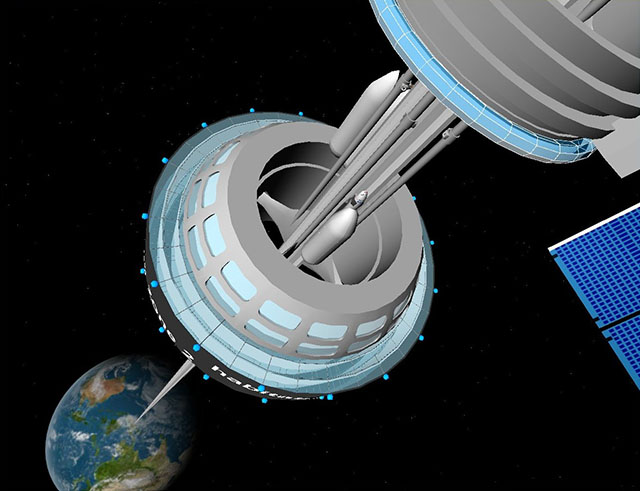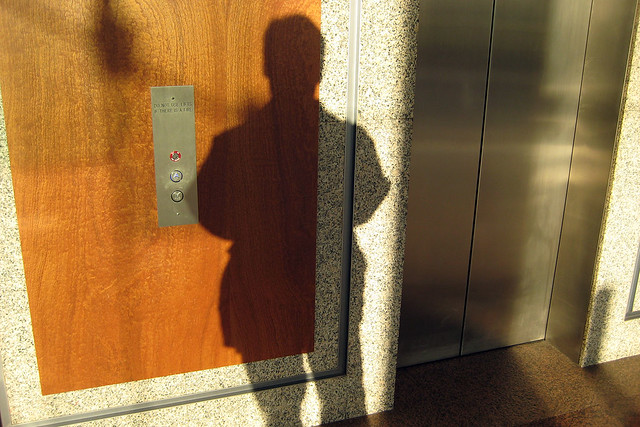

| Archive Blog Cast Forum RSS Books! Poll Results About Search Fan Art Podcast More Stuff Random |
|
Classic comic reruns every day
|
1 {photo of the interior of a lift}
1 Caption: Lift stories
|
First (1) | Previous (3354) | Next (3356) || Latest Rerun (2861) |
Latest New (5380) First 5 | Previous 5 | Next 5 | Latest 5 Annotations theme: First | Previous | Next | Latest || First 5 | Previous 5 | Next 5 | Latest 5 This strip's permanent URL: http://www.irregularwebcomic.net/3355.html
Annotations off: turn on
Annotations on: turn off
|
I've talked about one method of getting from one place to a higher place before, but with the miracles of modern technology there are plenty of other ways to accomplish the same thing. Stairs often exist in the context of buildings, so let's look first at how you might go about moving from one floor of a building to another.
The next most common thing we might use to change floors in a building is a lift. Americans call such things elevators, but I'm going to stick with the more British terminology. A lift is, essentially, a platform which can be raised or lowered in a vertical direction through the use of some more or less cunning mechanical contrivance. Often the platform is embellished into an enclosed box with doors, but this is not necessary. The box design enhances safety when the lift operates within an enclosed vertical shaft, as it prevents people from being able to poke their limbs into areas where they might get crushed or severed by large bits of architecture moving in close proximity to one another.
 Lift shaft. Creative Commons Attribution-NonCommercial-NoDerivs by Jose Ramon Borras. |
The two most common methods of moving lift cars are by cable, or hydraulic piston. Long travel lifts almost always use cables, which pull the car up with motorised wheels at the top of the shaft. The other end of the cable is connected to a counterweight, which travels down as the lift car travels up, and vice versa, reducing the amount of power needed to drive the wheels. The disadvantage with cable systems is that if the cable fails there is nothing keeping the lift car from falling down the shaft. So most modern lifts have safety brakes which clamp onto the guide rails inside the shaft in the event of failures. Hydraulic lifts operate differently, with the car perched atop a huge piston, which pushes it up the shaft by pumping hydraulic fluid (i.e. oil) into the piston chamber. Piston length limits this type of lift to only a small number of floors, typically three or four at most.
Some lifts operate without an enclosing shaft, simply rising into the air from one floor to another, and such lifts sometimes have open designs. Examples include the stereotypical basement to street level lift which can emerge from some American sidewalks. (I've never seen one of these lifts anywhere except in American movies and TV shows, so I have no idea if such things really exist anywhere else.) I have seen other cases where the lift is a platform with a safety fence around it to stop people falling off, and it is raised through a multi-level atrium on a hydraulic piston to a higher level where it docks with an edge of the floor above.
A sort of hybrid of these two is the glass lift, which is attached to a sort of semi-shaft along one wall, with the rest of the notional shaft missing or made of glass. The lift walls themselves either have glass panels or are just large sheets of glass, affording a view out and down as the lift travels. These can be panoramic and fun, or somewhat vertiginous and disconcerting, depending on your reaction to heights.
 Glass lift. |
Roald Dahl famously wrote a whole book about a magical lift made of glass, in Charlie and the Great Glass Elevator, the sequel to Charlie and the Chocolate Factory. These were two of my favourite childhood books. There was a movie of the first book, starring Gene Wilder[1]. I loved it and always hoped they would film the sequel, but for some reason they never did. (I discovered much later that Dahl hated the movie so much that he forbade any sequel from being filmed. Which just goes to show, I think, that Roald Dahl doesn't know everything about what sort of entertainment pleases children.) In the book, the elevator in question is not confined to a mere shaft, but can also travel sideways and slantways and so on, and can also travel freely through the air and even into space, making it much more versatile as a means of transport. But why does Dahl, a British author, refer to it as an "elevator" rather than a "Great Glass Lift"? In fact Dahl does refer to it as the "great glass lift" in the first book, but changes terminology early in the sequel. The answer is provided by Wonka himself:
"Madam," said Mr Wonka, "it is not a lift any longer. Lifts only go up and down inside buildings. But now that it has taken us up into the sky, it has become an elevator. It is the Great Glass Elevator."It seems the longer word has a more exotic and mysterious cachet for British children readers.
One type of speculative lift is known as a space elevator. First conceived by rocketry pioneer Konstantin Tsiolkovsky, this is a lift mechanism designed to carry objects from ground level into space. You do this by building a super long cable, such that the centre of mass of the cable is in a stationary orbit around the planet of celestial body in question. Imagine a communications satellite, in a geostationary orbit above Earth's equator. The satellite circles the Earth exactly once per day, but meanwhile the Earth spins once per day. The result is that from any given spot on the ground, the satellite appears not to move. Such satellites are extremely useful, as you can point an radio dish directly at one, and you never need to re-aim the dish to maintain continuous contact.
 Space elevator concept art. Creative Commons Attribution by Bruce Irving. |
All right, given such a geostationary satellite, now imagine extending a thin cable from it, towards the Earth. At the same time, you extend an equal length of cable in the other direction, away from Earth, to maintain the satellite's balanced position in the middle. You can have a cable poking out, say, a kilometre from the satellite in both directions, directly towards and away from Earth, and the centre of mass and therefore the orbit of the satellite remain unchanged. Extend the cables even further, and keep going. Imagine each cable is 35,800 kilometres long, with the satellite in the middle, still safely in geostationary orbit. Okay?
Now, if the cable extending towards Earth is 35,800 kilometres long, the end of it is almost touching the Earth's surface. From Earth, it will appear to be a long vertical cable just hanging from the sky, going up as far as the eye can see, with no visible means of support. Grab hold of the dangling bottom of the cable, attach it to a building or other structure. Now attach a cable car with a motor drive capable of crawling up the cable using a friction wheel. Such a car can haul itself all the way up the cable, until it reaches the satellite. It is now in space, with never a rocket being fired.[2] Once this space elevator is built, cars can climb up from Earth into high orbit, or conversely from orbit down to Earth. What's more, the cars coming down release gravitational potential energy which can be harnessed to help drive the up-going cars (though you'll lose some fraction due to inefficiency). Overall, this is a much easier and more energy efficient way to move cargos between space and the deep gravity well of a planet than using free vehicles.
As unlikely as it may seem, a space elevator is theoretically possible and dynamically stable. The main problem with building one is material strength and weight.[3] The stresses in the cable would be immense, and no construction material we currently possess has the necessary strength to weight ratio. But this doesn't mean it can't be done. People are constantly developing new and stronger materials. Also, the smaller the planet, the more feasible it is to build a space elevator for it. Kim Stanley Robinson's Red Mars trilogy makes a space elevator on Mars a major plot point. (And I used a space elevator for a gag once in this very comic.)
Coming back down to Earth, the general principle of lifts moving in a loop, with both up-going and down-going cars at the same time, is used in an old fashioned device known as a paternoster. This consists of two adjacent shafts, one containing lift cars which continuously move slowly upwards, while in the other shaft the cars always move down at the same speed. Cars reaching the top or bottom shunt across to the other shaft, so all the cars move in a continuous loop. Neither the cars nor the floors where they can be seen have doors. Standing on a floor next to a paternoster shaft, you see a succession of cars travelling continuously up (or down). To use the device, you merely step into a car as it comes past, and step out again when at your desired floor, all while the whole thing is still moving. If this sounds a bit risky to you, reflect on the fact that "paternoster" means "our father" in Latin, in invocation you may wish to make as you step across the moving threshold.
 An operating paternoster. Creative Commons Attribution-NonCommercial-NoDerivs by Lucas Weber. |
Somewhat related are Shabbat lifts, which can be found in places with significant Jewish populations. Orthodox Jewish religious law specifies that operating electrical devices on the day of Shabbat is prohibited. Pressing a call button or floor button on a lift counts. To avoid pressing any buttons, some lifts can be switched into Shabbat mode. In this mode, they automatically travel up and down all day, stopping at every floor, so a person can wait for a lift, get in, and travel to their desired floor without needing to press any buttons.
One interesting but little considered feature of lifts is the design of the layout of lift shafts and the scheduling of lift movements. If your building is really tall, you want to move people up and down it efficiently. Just having lifts that stop at each floor is a bad idea, since people travelling a long way will endure long trips that stop at multiple intermediate floors. Instead, it's better to have some shafts dedicated as express lifts, which skip, say, the lowest 20 floors of a 40-floor building. Your problem then is that for each shaft serving the lower 20 floors you also need a shaft serving the upper 20 floors. The thing about lifts is that they take up space inside a building, which you then can't use for offices of apartments or whatever. Above a certain number of floors, the number of lift shafts needed to provide adequate service for a tall building actually begins to require more internal volume than a typical building has. Above this limit, you need to do other things, such as break a single shaft into multiple self-contained sections, each section with a lift serving a continuous section of, say, 10 floors. Then you have an express lift which only stops at every tenth floor, where you change from the express to a local lift at what is called a sky lobby. Most supertall buildings employ this method to improve the space and time efficiency of their lift systems. (A reader writes that in some new systems you enter which floor you want to travel to, rather than just press a simple call button, and a scheduling program decides the most efficient lift car to send to get you. Cool!)
 Waiting, waiting... |
There's a lot more that can be said about lifts. Normally we don't pay them any attention at all, except when they annoy us by being too slow. The physical design of lifts, the functional concepts which go into them, and the abstract reasoning behind the efficient movement of people in a vertical direction all contribute to a surprisingly rich body of knowledge that can be discovered. Next time you're travelling vertically, ponder a bit on just how interesting that form of travel is.
[2] Not counting any rockets used to launch the initial satellite, that is.
[3] Actually there's a much bigger problem, as a reader pointed out to me. Earth currently has so much space junk in orbit that even if a space elevator could be built, it would be bombarded by so many dead satellites and miscellaneous space debris, that it would be rendered damaged and useless too quickly to be of any real use. The first step in building a space elevator is probably cleaning up all the requisite orbits.
|
LEGO® is a registered trademark of the LEGO Group of companies,
which does not sponsor, authorise, or endorse this site. This material is presented in accordance with the LEGO® Fair Play Guidelines. |